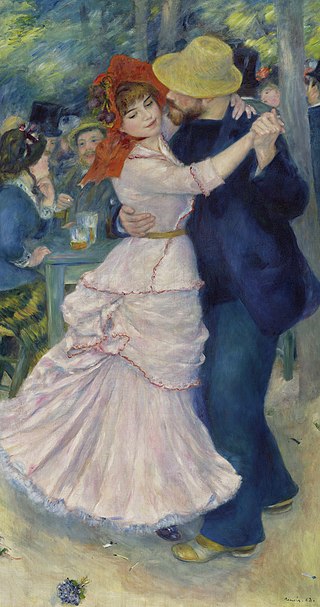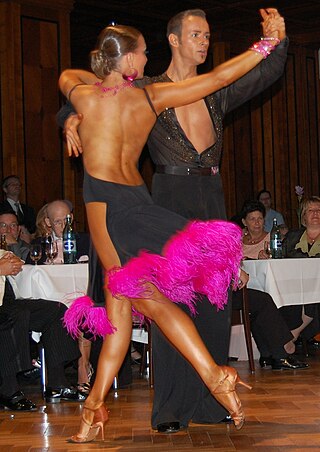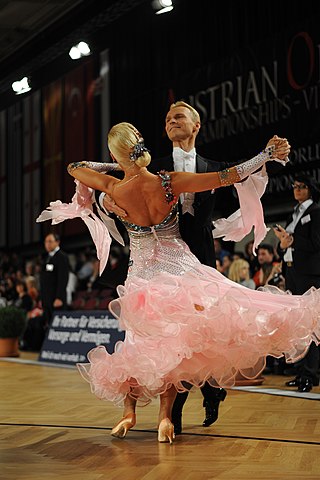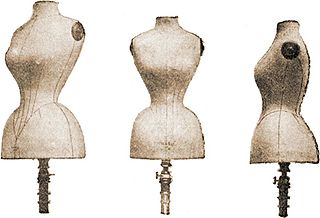The promenade position (abbreviated as PP in dance diagrams) is a dance position in ballroom and other dances. It is described differently in various dance categories.
The promenade position (abbreviated as PP in dance diagrams) is a dance position in ballroom and other dances. It is described differently in various dance categories.
The promenade position is a V-shaped dance position with the man's right hip and the woman's left hip in contact at the point of the "V", and with the man's left side and the woman's right side slightly open. The direction of travel is toward the openside.
The man and woman stand in front of each other in body contact, slightly offset to the left, with the middle of the woman's front connected to the man's right front. The connection begins at the upper thighs and should continue all of the way up to the middle of the torso. The man's left hand holds the woman’s right hand, palm to palm in an upper-hand clasp, with fingers and thumbs closed around partner's hand. The man's right hand must rest on the woman’s back, loosely cupped with fingers and thumb together (not spread apart). The man's hand connects to her back on her shoulder blade. His wrist should make contact with her underarm at the junction of her arm and body. This connection should not change from the basic closed position. The woman’s left hand and forearm must be on the man's upper arm. This connection should also not change from the basic closed position.
In ballroom dances their common trait is that when in promenade position, the dance couple moves (or intends to move) essentially sidewise to the leader's left while partners nearly face each other. Steps of both partners are basically sidewise or diagonally forward with respect to their bodies. Normally the dancers look in the direction of the intended movement.
In the International Standard and American Smooth dance categories the promenade position is described as a V-shaped dance position with the man's right hip and the woman’s left hip in contact at the point of the "V". The dancer's heads face the open portion of the "V". The intended direction of movement is in this direction as well, with some exceptions.
In International Standard, many pota ballroom partners strive to keep their shoulder lines close to parallel throughout a promenade, by means of an internal rotational stretch which is one of the more elusive dance concepts. Some expansion of the hold may often be seen, in the form of the leader stretching diagonally forwards and the follower diagonally back, each of course retaining their own largely independent balance. Diagonal movement across the feet and placement of the step of the inside foot into Contra body movement position may reduce the amount of hip turnout required for free movement. With proper foot usage, no sacrifice of motion is required to maintain this position. At the same time other skilled dancers often sacrifice the "narrowness" of the V-shape in favor of the amount of the progressive movement
Some dance moves started from the PP are Chasse, weave, and several others whose description includes the words "from PP", e.g., "Cross Hesitation from PP".
Some dance moves that may end in the PP are Open Telemark, Chasse
International Latin and American Rhythm dance categories usually do not involve the immediate body contact, but the general relative body positions are basically the same as described above, only the shoulder lines may remain parallel, i.e., one usually do not speak of V-shaped bodies position.
Some dance moves that may involve the PP are Botafogos (Samba) and Travelling Spins (Paso Doble).
In square dances the promenade is a side-by-side position, with the intention to move together forward. The dancers may use various promenade handholds. Some of them are:
In Lindy Hop, the promenade position is often defined similarly to the square dancing version: it is a side-by-side position with the leader's right arm on the follower's right shoulder, see, e.g., Lindy Basic.
In some types of partner dance, lead and follow are designations for the two dancers' roles in a dance pairing. The leader is responsible for guiding the couple and initiating transitions to different dance steps and, in improvised dances, for choosing the dance steps to perform. The leader communicates choices to the follower, and directs the follower by means of subtle physical and visual signals, thereby allowing the pair to be smoothly coordinated.

In partner dancing, closed position is a category of positions in which partners hold each other while facing at least approximately toward each other.

The schottische is a partnered country dance that apparently originated in Bohemia. It was popular in Victorian era ballrooms as a part of the Bohemian folk-dance craze and left its traces in folk music of countries such as Argentina, Finland, France, Italy, Norway ("reinlender"), Portugal and Brazil, Spain, Sweden, Denmark, Mexico, and the United States, among other nations. The schottische is considered by The Oxford Companion to Music to be a kind of slower polka, with continental-European origin.

Partner dances are dances whose basic choreography involves coordinated dancing of two partners, as opposed to individuals dancing alone or individually in a non-coordinated manner, and as opposed to groups of people dancing simultaneously in a coordinated manner.
Soviet ballroom dance was a category of ballroom dance competitions in the former Soviet Union. Competitions in Ballroom dancing in the USSR were held in three dance categories: Standard dances, Latin dances, and Soviet dances.
This is a list of dance terms that are not names of dances or types of dances. See List of dances and List of dance style categories for those.

In ballroom dancing, directions of progressive movement, in particular directions of steps, can be indicated either in relation to the room or in relation to the body position. Directions of turns, although there are only two of them, may also be indicated in several ways.
Because ballet became formalized in France, a significant part of ballet terminology is in the French language.

Bulgarian folk dances are intimately related to the music of Bulgaria. This distinctive feature of Balkan folk music is the asymmetrical meter, built up around various combinations of 'quick' and 'slow' beats. The music, in Western musical notation, is often described using compound meter notation, where the notational meter accents, i.e., the heard beats, can be of different lengths, usually 1, 2, 3, or 4. Many Bulgarian dances are line dances, in which the dancers dance in a straight or curved line, holding hands.
Promenade is a basic dance move in a number of dances such as English Country Dance, contra dance, and square dance. The name comes from the French word for "walk" and is a good basic description of the dance action.
The country/western two-step, often called the Texas two-step or simply the two-step, is a country/western dance usually danced to country music in common time. "Traditional [Texas] two-step developed, my theory goes, because it is suited to fiddle and guitar music played two-four time with a firm beat [found in country music]. One-two, one-two, slide-shuffle. The two-step is related to the polka, the Texas waltz, and the jitterbug.
The Texas two-step is the same step known to ballroom dancers as the international fox-trot. Except for the one-step, which is just that, most Texas dances are variations of a two-step, also called a half-step, which is simply a step-close-step. The Texas two-step is generally done with two long steps and a step-close-step to two-four time. Speeded up, it's a shuffle or double shuffle, but still a two-step.

Contra body movement is used in ballroom dances, such as waltz, foxtrot, tango, and quickstep. It comprises turning the body against the movement of the legs: either moving forward with the right foot and the left hip and shoulder, or vice versa.
The counter promenade position is a dance position in ballroom and other dances. It is described differently in various dance categories, but essentially it is the opposite of the promenade position.
Contra dance choreography specifies the dance formation, the figures, and the sequence of those figures in a contra dance. The figures repeat, ideally, in a graceful flowing pattern, aligned with the phrasing of the music. Contra dance figures do not have defined footwork; within the limits of the music and the comfort of their fellow dancers, individuals move to the beat and embellish according to their own taste. Much of the dance is done as a walking movement, one step for each count of the music, while the arms and hands do most of the changing, most of these involving connecting with others' hands.

Figure skating lifts are required elements in two disciplines of figure skating: pair skating and ice dance. There are five groups of lifts in pair skating, categorized in order of increasing level of difficulty. Judges look for the following when evaluating pair lifts: speed of entry and exit; control of the woman's free leg when she is exiting out of the lift, with the goal of keeping the leg high and sweeping; the position of the woman in the air; the man's footwork; quick and easy changes of position; and the maintenance of flow throughout the lift. Twist lifts are "the most thrilling and exciting component in pair skating". They can also be the most difficult movement to perform correctly. They require more strength and coordination than many other pair elements, and are usually the first or second element in a program. According to the International Skating Union (ISU), "the Woman must be caught in the air at the waist by the Man prior to landing and be assisted to a smooth landing on the ice on a backward outside edge on one foot" during a twist lift. A pair lift and twist lift is required in the short program of pair skating; a well-balanced free skating program in pair skating must include lifts.

A dress form is a three-dimensional model of the human torso used for fitting clothing that is being designed or sewed. When making a piece of clothing, it can be put on the dress form so that one can see the fit and drape of the garment as it would appear on a body and make adjustments or alterations. Dress forms come in all sizes and shapes for almost every article of clothing that can be made. Dress forms in the standard clothing sizes are used to make patterns, while adjustable dress forms allow garments to be tailored to fit a specific individual.
A handhold is a manner in which the dancers hold each other's hands during the dance. A hold is the way one partner holds another one with hands. Hold and handhold are important components of connection in dance.

Arabesque in dance, particularly ballet, is a body position in which a dancer stands on one leg–the supporting leg–with the other leg–the working leg–turned out and extended behind the body, with both legs held straight.

The Values of Civilization sculpture group is public art by American artist Alexander Doyle. The allegorical sculpture group is located on the third floor in the rotunda of the Indiana State House, which is in Indianapolis, Indiana, United States. The heroic-sized sculptures, representing Agriculture, Art, Commerce, History, Justice, Law, Liberty, and Oratory, were carved from Carrara marble in Italy in the late 1880s.